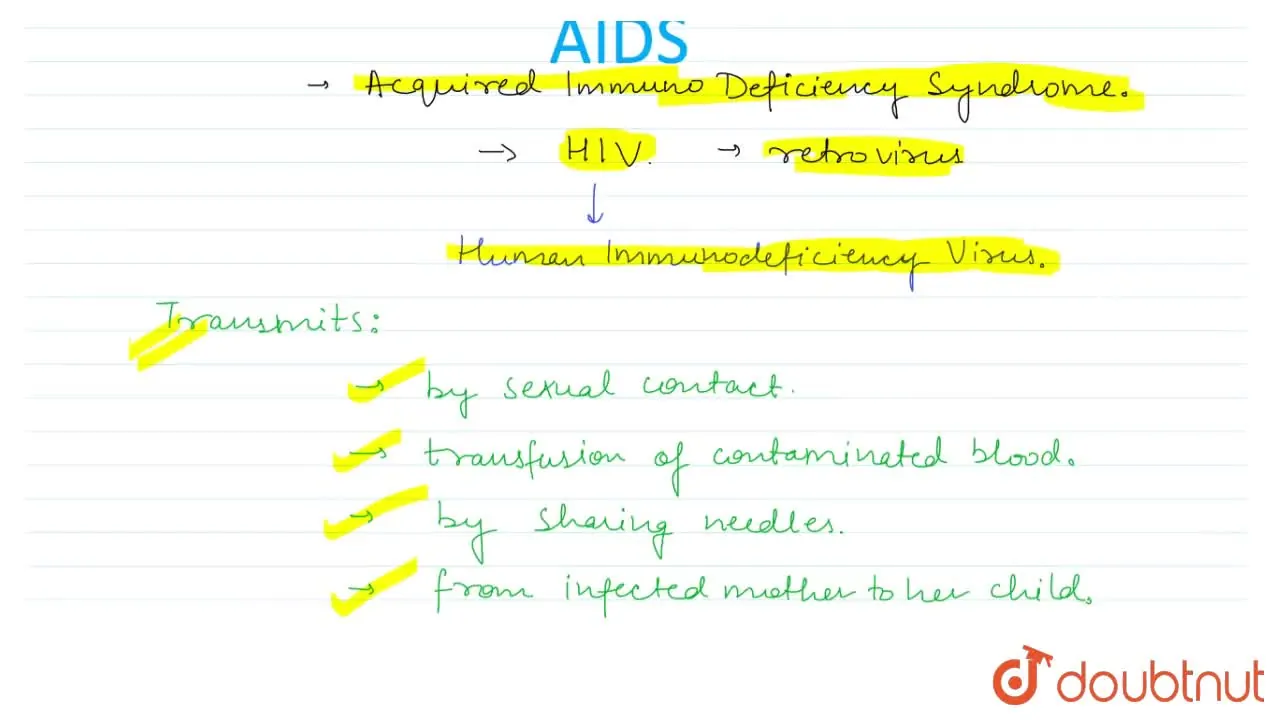Aids
AIDS
We will study about Aids in this chapter. We will have a look at the causes as well as symptoms of aids.
What is AIDS?
AIDS is an acronym of Acquired Immune Deficiency Syndrome. It is a syndrome that is caused by HIV. When a person suffers from AIDS, his or her immune system becomes too weak where it becomes impossible or difficult to fight off any sort of disease or infection. It is also the last stage of HIV infection. If proper treatment is not provided, it might lead to death. It makes a person vulnerable to a wide range of illnesses like:
- Pneumonia
- toxoplasmosis, a brain infection that is caused by a parasite
- oral thrush which is a fungal infection in the mouth or throat
- cancer, including Kaposi’s sarcoma (KS) and lymphoma
- cytomegalovirus (CMV), a type of herpes virus
- tuberculosis
- cryptococcal meningitis which is a fungal infection in the brain
- cryptosporidiosis, an infection which is caused by an intestinal parasite
What are the causes of AIDS?
It should be noted that HIV causes AIDS. If a person has not contracted HIV, then he or she cannot get AIDS. Normally there is a CD4 count of 500 to 1500 per cubic millimeter in a healthy individual. If a person does not undergo treatment, then HIV would continue to multiply and also destroy CD4 cells. In case the CD4 count of a person falls below 200, then they have AIDS. At the same time, if an opportunistic infection associated with HIV is developed by someone with HIV, then it is possible to get diagnosed with AIDS. This can be done even of the CD4 count of the person is above 200.
What are the symptoms of AIDS?
Some symptoms of AIDS include:
- recurrent fever
- chronic fatigue
- night sweats
- recurrent or chronic diarrhea
- neurologic problems
- rapid weight loss
- bumps, lesions, or rashes of the skin
- dark splotches under the skin or inside the nose, mouth, or eyelids
- chronic swollen lymph glands, especially of the neck, armpits, and groin
- anxiety and depression
- spots, sores, or lesions of the tongue and mouth, genitals, or anus
Related Videos:
- AIDS is characterised by
- AIDS is caused by
- AIDS spreads through
- AIDS is tranmitted
- HIV in AIDS affects
What are the symptoms of late-stage HIV infection?
The symptoms of late-stage HIV infection include the following:
- Blurred vision
- Fever of above 37 degrees Centigrade (100 degrees Fahrenheit)
- Permanent tiredness
- Swollen glands lasting for weeks
- Dry cough
- Weight loss
- Night Sweats
- Persistent or Chronic Diarrhea
- White spots on the tongue or mouth
- Shortness of breath
What tests are used to diagnose HIV?
There are several tests that are used in diagnosing HIV. It is determined by the healthcare providers as to which tests are the best for each person. Some of the tests are:
-
Antibody/antigen tests: The most commonly used tests are the antibody/antigen tests. It becomes possible for you to show positive results with 3 weeks to 7 weeks. This test is done in order to check the blood for antigens and antibodies.
-
OraQuick HIV Test: This is an oral swab that helps in making it possible to provide results in as little as 20 minutes.
-
Home Access HIV-1 Test System: Here, the finger is pricked of the person where the blood sample is sent to a licensed laboratory. This test needs to be repeated in three months in case someone suspects that they have been exposed to HIV but have been found to be negative.
-
Nucleic acid test (NAT): This is a very expensive test and is not used in general screening. This test is for people who have early symptoms of HIV. It helps in providing an accurate result for the virus rather than looking for antibodies.
Important Chapters:
Antibody/antigen tests: The most commonly used tests are the antibody/antigen tests. It becomes possible for you to show positive results with 3 weeks to 7 weeks. This test is done in order to check the blood for antigens and antibodies.
OraQuick HIV Test: This is an oral swab that helps in making it possible to provide results in as little as 20 minutes.
Home Access HIV-1 Test System: Here, the finger is pricked of the person where the blood sample is sent to a licensed laboratory. This test needs to be repeated in three months in case someone suspects that they have been exposed to HIV but have been found to be negative.
Nucleic acid test (NAT): This is a very expensive test and is not used in general screening. This test is for people who have early symptoms of HIV. It helps in providing an accurate result for the virus rather than looking for antibodies.
Similar Questions
Taxonomy And Taxonomical Aid
View SolutionFirst aid
View SolutionThe absorptive nutrition of fungi is aided by
View SolutionWhat is first aid?
View SolutionWhat is first aid ?
View SolutionThe digestion of fats in the intestines is aided by
View SolutionThe digestion of fats in the intestines is aided by
View SolutionWhich of these is an example of electronic aid?
View SolutionCHARITY : AID
View Solution


